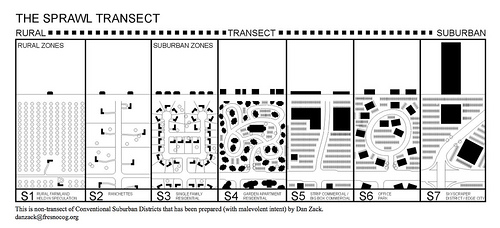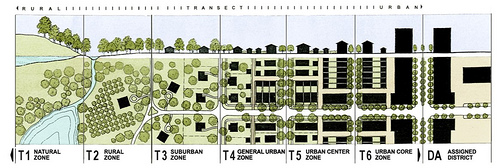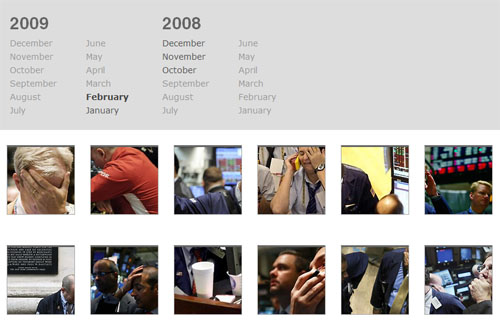Sticky Postings
All 242 fabric | rblg updated tags | #fabric|ch #wandering #reading
By fabric | ch
-----
As we continue to lack a decent search engine on this blog and as we don't use a "tag cloud" ... This post could help navigate through the updated content on | rblg (as of 09.2023), via all its tags!
FIND BELOW ALL THE TAGS THAT CAN BE USED TO NAVIGATE IN THE CONTENTS OF | RBLG BLOG:
(to be seen just below if you're navigating on the blog's html pages or here for rss readers)
--
Note that we had to hit the "pause" button on our reblogging activities a while ago (mainly because we ran out of time, but also because we received complaints from a major image stock company about some images that were displayed on | rblg, an activity that we felt was still "fair use" - we've never made any money or advertised on this site).
Nevertheless, we continue to publish from time to time information on the activities of fabric | ch, or content directly related to its work (documentation).
Friday, May 14. 2010
Save the Date: Postopolis! DF
In just under a month, I am delighted to announce, I will be eagerly exploring the edible geography of Mexico City. The occasion is Postopolis! DF, the third in a series of events organised by Storefront for Art and Architecture. Postopolis! was launched in New York City in 2007, and it happened all over again in L.A. in 2009. I was lucky enough to attend both events as an audience member, and to be invited to participate this time is an honour indeed.
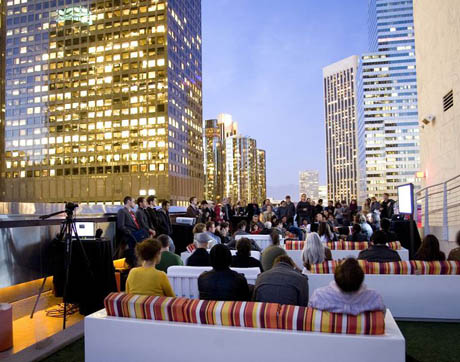
IMAGE: Postopolis! LA
The way Postopolis! works is that a handful of bloggers are invited to co-curate five days of back-to-back presentations and discussions that approach the field of urban and landscape design from as many disciplines and perspectives as possible. The list of participating blogs this year forms an impressive group: Urban Omnibus (Cassim Shepard), Intersections (Daniel Hernandez), DPR Barcelona (Ethel Barona Pohl), Toxico Cultura (Gabriella Gomez-Mont), Tomo (Guillermo Ruiz de Teresa), Mudd Up! (Jace Clayton a.k.a DJ /rupture), We Make Money Not Art (Regine Debatty), Strangeharvest (Sam Jacob), and Wayne & Wax (Wayne Marshall).
Together, we’re putting together a list of speakers that ranges from government officials to DJs, academics to urban farmers, and waste disposal experts to documentary filmmakers—via a healthy sprinkling of artists, architects, and designers.
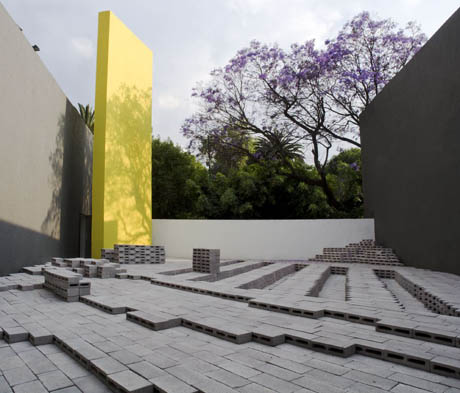
IMAGE: The courtyard at El Eco.
The five-day marathon will take place from 4 p.m. onwards between Tuesday, June 8, and Saturday, June 12, at the Museo Experimental El Eco in the Reforma Avenue neighbourhood of Mexico City. It is completely free and open to the public, the talks will be conducted in either Spanish or English, with simultaneous translations available, and each day will end with an after-party hosted by local music blogs. Rumour has it, the entire event will be streamed live online—I’ll confirm that nearer the time.
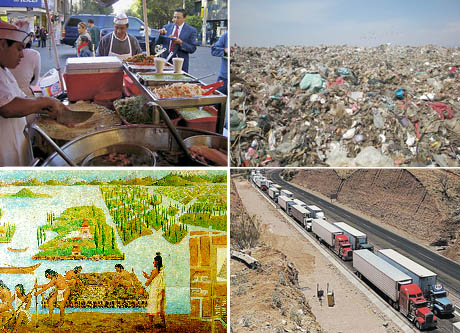
IMAGE: Clockwise: street food, the Bordo de Xochiaca dump, chinampas, and Mexican refrigerated trucks waiting to cross into the U.S.
Mexico, and Mexico City itself, offer a huge amount to discuss in terms of edible geography, from the chinampa system and the wheat and maize research of CIMMYT, to a fabulous diversity of street food and the U.S. FDA’s overseas expansion. Although the full speaker list and schedule is yet to be confirmed, Postopolis! DF is shaping up to be a pretty interesting event, and I definitely hope to see some of you there.
Related Links:
Personal comment:
This is a great event to which we took paert last year in LA (Postopolis! LA). Lots of ideas and speculations pop out from this event. If you have the occasion to go or be around (which won't be my case unfortunately), go!
Wednesday, January 27. 2010
Les vertus nouvelles de la circulation circulaire de l'information
Les temps changent. Et la notion de « circulation circulaire de l’information », qui était vicieuse dans le discours du sociologue
Cette idée d’inversion de la valeur attachée à cette notion n’est pas de moi. Je l’ai lue quelque part, mais je ne souviens pas où. Je la fais donc circuler sans référence à la source, ce qui rompt un peu, précisément, le flux de circulation circulaire. A me lire ici, on pourrait croire que j’en suis la source, alors que je ne suis qu’un « circulateur » [1]… ![]() [2]
[2]
Mais j’ai un autre bon exemple sous la main. Suivez, pas à pas, le processus de circulation circulaire :
- un billet de Mathieu, relevant une perle dans le rapport Gaymard sur le livre ;
- cité par Nicolas Vanbremeersch, sur Meilcour ;
- lequel est cité par narvic, ici-même ;
- lequel est cité par Hubert Guillaud, sur La Feuille.
Dans cette chaîne, chacun de ceux qui citent renvoie vers tous ceux qui ont cité précédemment. Et le tout suscite, à chaque citation, une « grappe » de commentaires « sur place » de la part du lectorat particulier de chacun des « citateurs ».
Chacun des « citateurs » commente l’information initiale et la « reformate » à destination de son propre lectorat, permettant ainsi d’en accroître la diffusion. Le processus se propage « en grappe » lui-aussi, chaque point de citation étant potentiellement le noeud d’une nouvelle propagation. Le message initial se métamorphose durant le processus (avec probablement des pertes et des gains d’informations au passage : des simplifications ou des enrichissements), mais c’est - en définitive - la diffusion globale du message initial qui est accrue par ce processus « en avalanche »…
Il y a là de quoi réfléchir. C’est vraiment, à mon avis, un nouveau mode de circulation de l’information qui s’illustre ici : une circulation de noeud en noeud, au sein d’un réseau « en grappes ».
Ce modèle n’a que peu de chose à voir avec celui de la circulation de l’information dans les réseaux « traditionnels » des médias (presse écrite, radio, télévision), comme je le suggérais récemment (cette question fait partie de « mon programme de travail sur ce blog »).
Une idée de là où je veux en venir, dans cet article de Alexandre Steyer [3] et Jean-Benoît Zimmermann [4] : Influence sociale et diffusion de l’information (15 pages, en .pdf). Résumé :
La notion de diffusion, quel que soit son objet, est centrale pour tout système ou construction sociale, car elle se trouve à la base de la mise en cohérence des comportements des individus ou de leurs représentations, donc de la coordination de leurs actions. L’idée, à l’origine de la notion de diffusion, est que les interactions entre individus sont le moteur principal de l’évolution de leurs comportements, croyances ou représentations. Notre démarche dans cet article est celle des réseaux d’influence sociale, dans lesquels l’agent est situé dans une structure de nature résiliaire où la progression de l’influence est contingente d’effets de cumul. Après avoir exposé les principes d’un modèle de diffusion en réseau, fondé sur une dynamique de cheminement de l’influence sociale, nous étudions la manière dont cette influence se propage sous la forme d’« avalanches », donnant par là une importance fondamentale à la structure du réseau. Nous analysons comment le bruit, généré par ces avalanches constitue une signature de la structure sociale et peut en retour contribuer, par effet d’apprentissage, à modifier cette structure et donc la dynamique [de] diffusion. Nous expliquons alors pourquoi émergent des courbes de diffusion « critiques » singulières, en loi de puissance, au lieu de la forme exponentielle des courbes de diffusion traditionnelles.
Quand la blogosphère joue à plein de cette « circulation circulaire » de blog en blog, qui permet la formation d’effets de diffusion « en avalanche », les médias en ligne, dans leur logique de sites « portails de l’information », de « sites de destination », ne sont pas en mesure de le faire. Ils ne sont plus qu’un maillon dans une chaîne, et c’est la chaîne - non plus le média - qui assure la diffusion en ligne. Les journalistes n’ont pas encore pris conscience de cette nouveauté et ne s’y sont pas encore réellement adaptés : s’ils veulent jouer un rôle dans la diffusion de l’information, c’est dans la dimension sociale d’internet que ça se joue, c’est à dire hors de leur site et après la mise en ligne. C’est ce qui me pousse à penser que l’avenir du journalisme en ligne est dans l’immersion dans les réseaux sociaux du net, ce qui est une autre aspect de la question déjà posée précédemment : Les sites d’info doivent-ils migrer sur Facebook et dans les blogs ?
On va en reparler sur ce blog… ![]()
-----
Via Novövision
Personal comment:
Un commentaire très à propos par rapport à la nature même de ce blog de "veille" (celui de fabric | ch). J'aime assez l'idée et l'image d'"avalanche informationnelle", qui serait donc constituée par la masse des "reblogs" et autres "reposts" ou citations.
Merci à Nicolas Besson pour le lien.
Tuesday, May 12. 2009
New Spatialism:? Reclaiming Social Space In Web Media
I am going to be leading a Social Media Masterclass at the Thinking Digital conference on Wednesday, as just one element of a two week trip in Europe. Last week I was in Hamburg for the Next09 conference, and Andreas Vascellari got a video of my presentation on the Open Enterprise 2009 study, and interviewed me, as well. This week, it's Thinking Digital, Futuresonic, and Somesso, in Newcastle, Manchester, and London. Yikes.
But having a whirlwind tour with four very different presentations is an interesting experience, particularly since I get a chance to stare out the window and try to get down what I really believe on various topics.
For Thinking Digital I will be leading a two hour masterclass on social media. I opted to go with a 'late night TV' approach, where I am the host and I have various guests that join me one by one: Dan Lyons, JP Rangaswami, and Paul Smith. Each has the option to do some schtick for a few minutes -- although most are opting to just sit down for an interview -- and I am starting off with a monologue. I just wish we could have a band. After the first hour of the show we will switch to an interactive mode, where I will wander the floor with a mike, involving the attendees very directly in a give-and-take with my guests.
So I had a chance to think about what I wanted to say in my monologue to set the context for a masterclass in social media. Perhaps those attending want me to focus on the nuts-and-bolts of being a successful blogger or driving more revenue or branding your blog. I will make sure my guests and I touch on those topics later in the show, but I wanted to use my starting spot for a different purpose.
Looking back on ten years of blogging, I think we have arrived at a turning point, where we have to reclaim the social space in web media.
Ten years ago, when I started blogging, it wasn't called blogging yet. I thought I was writing an 'e-zine' although it had all the characteristics of a blog: reverse chronological entries, categories, and so on.
We were like pioneers, fooling around out in the wilderness, cutting crude roads, building villages.
Relatively soon, however, this personal publishing by the fringe lunatics became big business and old media arrived. Now the leading 'blogs' are either run by old media giants, or bloggers who have become new media giants. Social media has been strip-malled. The funky soulfulness of the early days has been replaced by SEO, ad networks, and ersatz earnestness.
The reality is that so-called social media -- even in its earlier, Birkenstock and granola days -- wasn't very social. We didn't call it that until much later, anyway. We thought of it as personal publishing, and it adopted the basic dynamics of publishing. Most notably, there was a publisher or author and then there were readers. It seemed more egalitarian since anyone could be a publisher, but still there was a broadcast media dynamic despite the fact that anyone could argue or agree with someone else's posts on their own blog. Then for a few years, we just called it blogging. Rhymes with slogging, because, in the final analysis, most people didn't blog: too hard, too much work, not rewarding enough.
But the format is perfect for publishing companies, which is why the largest 'blogs' now are generally corporate media machinery. And as the blogosphere has become an increasingly corporate neighborhood, people are moving out.
I noticed a few years ago that comments seemed to be moving from blogs into faster paced social tools, like Facebook and then streaming apps like Twitter. (Twitter has become so popular that most of the competitors have closed shop). People are moving to where things are more social, where the author/audience divide is less sharp, and where the scale of interaction is human-sized. This is the new loft district: social networks.
Social networks are truly social, where web media isn't, very.
Social networks are really about individuals and their personal relationships with others. So, if web media is to really become social -- which it isn't at present -- we need to take what we have learned from other, more social tools, and take another run at social media.
Using an analogy from city planning and architecture, we need a rethinking of the basics: something like the New Urbanism movement, that tried to reclaim shared urban space in a way that matches human needs, and moved away from gigantic and dehumanizing cityscapes of the mid and late twentieth century, where garbage trucks seemed more at home than a teenage girl walking a dog.
So, we need a New Spatialism movement, to rethink web media and reclaim the social space that is supposed to be central to so-called social media. Some web media may just remain what it is, like an industrial district at the edge of town. But at least some parts of web media should be reconceptualized, and reconstructed to get back to human scale. Just as New Urbanism is about organizing streets, sidewalks, and plazas to support the growth of social capital, New Spatialism would help us channel interactions on line to increase sociality, and thereby increase the growth of social capital.
New Spatialism is based on the idea that our primary motivations for being online are extra-market drivers: we are not online for money, principally. We have created the web to happen to ourselves: to shape a new culture and build a better, more resilient world. And we need better media tools than we have at present, to make that a reality.
-----
Via /Message (Steve Boyd)
Personal comment:
Une analogie entre urbanisme et web media / social media. Et un constat par Steve Boyd concernant l'évolution désormais fortement "corporate" du web. Les gros poissons se sont réappropriés les outils qui pendant un moment furent entre les mains des individus et participèrent à l'émergence d'une sphère publique au niveau média en ligne.
Le point intéressant développé par Boyd est de revendiquer la nécessité d'une telle sphère online (d'où l'analogie avec l'urbanisme et l'architecture) et que les groupes "corporate" aménagenent cette place. Bonne chance toutefois pour ce dernier point...
Thursday, April 09. 2009
The scale of London’s food related greenhouse gas emissions is published
The Greater London Authority has published a report on London’s food related greenhouse gas emissions. It finds that food consumption in the capital accounts for 19 million tonnes of greenhouse gases per year - a very significant figure. 44% of these emissions are attributable to the agricultural stage.
Suggested ways to reduce this:
Less meat and dairy, and more food from plants. According to latest figures from the United Nations, animal farming globally causes more greenhouse gas emissions than all of the cars, lorries and planes in the world put together, and the impact is increasing.
More local, seasonal and field-grown fruit and vegetables.
Food, such as organic, grown without artificial chemicals - particularly artificial fertiliser, the main source of the potent greenhouse gas nitrous oxide.
Further Information:
The GLA report can be downloaded here
Information about the links between food and climate change can be found on the Sustain website here:
For background information and regular updates on food and climate change research and scientific findings, join the Food Climate Research Network mailing list via:
-----
Via MetaboliCity
Related Links:
Personal comment:
Rachel Wingfield's new project: MetaboliCity (probably a research project).about urban farming, etc. Here some interesting facts regarding CO2 emissions related to London's food consumption (grey energy maybe missing here)
Friday, March 06. 2009
Broker's blog
En passant, un drôle de blog: Brokers with hands on their faces blog, qui en dit long sur l'état de crise (permanente). Ça vit jusqu'à quel âge en moyenne un brooker?
-
-----
Personal comment:
Encore un drôle de blog qui prouve l'intérêt de ces passions incongrues postées sur le réseau.
fabric | rblg
This blog is the survey website of fabric | ch - studio for architecture, interaction and research.
We curate and reblog articles, researches, writings, exhibitions and projects that we notice and find interesting during our everyday practice and readings.
Most articles concern the intertwined fields of architecture, territory, art, interaction design, thinking and science. From time to time, we also publish documentation about our own work and research, immersed among these related resources and inspirations.
This website is used by fabric | ch as archive, references and resources. It is shared with all those interested in the same topics as we are, in the hope that they will also find valuable references and content in it.
Quicksearch
Categories
Calendar
|
|
July '25 | |||||
| Mon | Tue | Wed | Thu | Fri | Sat | Sun |
| 1 | 2 | 3 | 4 | 5 | 6 | |
| 7 | 8 | 9 | 10 | 11 | 12 | 13 |
| 14 | 15 | 16 | 17 | 18 | 19 | 20 |
| 21 | 22 | 23 | 24 | 25 | 26 | 27 |
| 28 | 29 | 30 | 31 | |||
